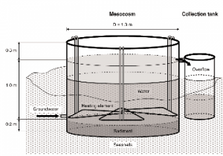Facilities
Transnational Access
Metadata & Data
Papers & Reports
Knowledge Base
AU Lake Mesocosm Warming Experiment (LMWE)
Aarhus University (AU)
Infrastructure Description
The Lake Mesocosm Warming Experiment (LMWE) is a unique long-term (with 16 years so far the world’s longest running) flow-through mesocosm experiment addressing climate-change effects on lakes under contrasting nutrient levels and water clarity. Twenty-four cylindrical outdoor mesocosms are used, each with a capacity of 2.8 m3. The mesocosms receive groundwater 6 times per day, resulting in a theoretical water retention time of 2.5 months. Water in the mesocosms is continuously mixed by paddles and heated by electrical elements. Three temperature regimes are run: ambient temperature and two elevated temperatures according to IPPC climate scenarios A2 and A2 + 50%, down-scaled to local 25 25 km grid cells. The modelled temperature difference for the A2 scenario is generally higher in August to January (max. 4.4 °C in September) than during the rest of the year (min. 2.5 °C in June). Individual mesocosms of each temperature regime are run at either low or high nutrient concentrations (4 replicates per treatment). The latter are obtained by weekly dosing of N and P.
Located 15 km from AU Silkeborg, the facility is equipped with a small lab building to facilitate accessory small-scale studies and analyses. A fully equipped lab is available at the AU freshwater central lab in Silkeborg. The mesocosm facility is part of the Danish AnaEE project and it is also included in the European AnaEE list of experimental facilities for ESFRI.

Facility Description
outdoor – pelagic/benthic – freshwater
24 cylindrical outdoor mesocosms, each 2.8 m3 in volume
Organisation Address
Aarhus University (AU)
Nordre Ringgade 1
Aarhus C
8000
Denmark
Infrastructure Address
Silkeborg
Denmark
Information Sources
Location
Gallery
Contacts
Thomas Davidson
Erik Jeppesen
Controlled Parameters
Nutrients, temperature
Research Topics
A unique long-term flow-through mesocosm facility with 11 years so far the world’s longest running mesocosm experiment addressing climate-change effects on lakes under contrasting nutrient levels and water clarity, population- and seasonal dynamics of underwater plants, plankton, production, respiration, stable isotopes, bacteria, fluxes of nutrients
Experiment Years
2003-present
TA Support
Services currently offered by the infrastructure: The LMWE provides a unique opportunity to test for long-term warming impacts on trophic dynamics, nutrient balances, ecosystem metabolism, greenhouse gas exchange, adaptation and microevolution that are not possible at other locations in the world. Users have access to laboratories, instrumentation, etc. at the mesocosm facility and the AU freshwater lab in Silkeborg. Users of LMWE meet a highly international scientific community with many guests from both Europe and overseas. This includes numerous students and postdocs from Europe, Israel, China, Argentina and Turkey. Close cooperation with local scientists is encouraged to maximise outcomes.
The mesocosm facility is part of the Danish AnaEE project and it is also included in the European AnaEE list of experimental facilities for ESFRI. The facility was part of FP7 projects REFRESH project and MARS (http://www.mars- project.eu), running from 2014-2018, to assess effects of a heat-wave on shallow lakes. Additional projects are the European JPI Water project PROGNOS (2016-2019) assessing in-lake responses to change using near real-time models, and a Danish lake restoration project (CLEAR from 2012-2017; a Villum Kann Rasmussen Center of Excellence on lake restoration) involving a 15N spiking experiment.
Support offered under AQUACOSM: All visitors will have access to the laboratories and instrumentation available at the facility. Beyond access to the LMWE, all users will receive scientific support for planning activities before and after arrival (typically initiated several months in advance) and hands-on training by the local scientific team. The visiting scientists will meet 1) an internationally leading team of aquatic scientists, headed by one of the most cited aquatic ecologists in the world and 2) a stimulating international environment with numerous scientists, students and postdocs from around the globe. The visitors will further benefit from competent technical and administrative staff associated with the facility, who can provide technical advice and assist with the purchase of consumables, lodging and other technical and administrative issues.
Support offered under AQUACOSM-plus: All users will have access to the laboratories and instrumentation available at the facility. Scientific support for planning activities before and after and hands-on training by the local scientific team will also be offered and users will benefit from advice provided by technical and administrative staff. User will meet 1) an internationally leading team of aquatic scientists, headed by one of the most cited aquatic ecologists in the world and 2) a stimulating international environment with numerous scientists, students and postdocs from around the globe.
TA Modality of Access
Modality of access under AQUACOSM: A total of 900 person-days will be allocated to external users through AQUACOSM Transnational Access provision in years 2-4. Access is offered to a minimum of 6 persons for 50 days each year.
Modality of access under AQUACOSM-plus: A total of 550 person-days will be allocated to external users through AQUACOSM TA provision. It is anticipated that AQUACOSM-plus will support stays of at least 6 persons for 23 days per year in M10-21 and M34-45.

